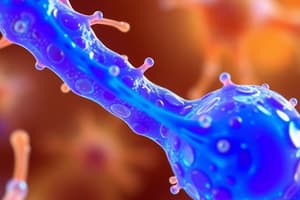Podcast
Questions and Answers
The amoeba can sense its environment, move around, obtain its food, maintain its structure, and ______
The amoeba can sense its environment, move around, obtain its food, maintain its structure, and ______
multiply
Genes present in the nucleus hold the ‘information’ necessary for the cell to function, and the nucleus resides in a jelly-like fluid called the ______
Genes present in the nucleus hold the ‘information’ necessary for the cell to function, and the nucleus resides in a jelly-like fluid called the ______
cytoplasm
Cytoplasm contains the cellular organelles, the ‘little organs’ in the cell, and these organelles carry out specific tasks based on instructions provided by the ______
Cytoplasm contains the cellular organelles, the ‘little organs’ in the cell, and these organelles carry out specific tasks based on instructions provided by the ______
genes
The textbooks paint a picture of a cellular ‘assembly line’ where genes issue instructions for the manufacture of proteins that do the work of the body from day to day. This textbook description of the cell matches, almost word for word, a social ______
The textbooks paint a picture of a cellular ‘assembly line’ where genes issue instructions for the manufacture of proteins that do the work of the body from day to day. This textbook description of the cell matches, almost word for word, a social ______
The picture of the cytoplasm and its organelles performing the work of ‘manufacturing’, ‘packaging’ and ‘shipping’ molecules according to ‘instructions’ from the genes eerily evokes the social hierarchy of executives ordering the manual labour of toiling ______
The picture of the cytoplasm and its organelles performing the work of ‘manufacturing’, ‘packaging’ and ‘shipping’ molecules according to ‘instructions’ from the genes eerily evokes the social hierarchy of executives ordering the manual labour of toiling ______
The only problem is that the cell is not a ‘factory’. It does not have a ‘control ______’
The only problem is that the cell is not a ‘factory’. It does not have a ‘control ______’
The assumption of ______ control distorts our understanding of the cell.
The assumption of ______ control distorts our understanding of the cell.
The cellular organelles do not just form a linear '______' but interact with each other in complex ways.
The cellular organelles do not just form a linear '______' but interact with each other in complex ways.
The 19th-century German biologist Rudolf Virchow wrote that 'starch is transformed into sugar in the plant and animal just as it is in a ______'.
The 19th-century German biologist Rudolf Virchow wrote that 'starch is transformed into sugar in the plant and animal just as it is in a ______'.
As researchers investigated the organelles, from the manufacture of protein in the ______ to the production of energy in the mitochondria, his metaphor of 'a factory' guided how scientists talked about these organelles.
As researchers investigated the organelles, from the manufacture of protein in the ______ to the production of energy in the mitochondria, his metaphor of 'a factory' guided how scientists talked about these organelles.
Some thought that the sperm contained a ______, a tiny version of the body, already fully formed.
Some thought that the sperm contained a ______, a tiny version of the body, already fully formed.
Others thought that the biological mother provided all material contribution to the ______, while the father lent only a 'generative force' to propel the egg into development.
Others thought that the biological mother provided all material contribution to the ______, while the father lent only a 'generative force' to propel the egg into development.
Flashcards are hidden until you start studying
Study Notes
Cell Biology and Social Hierarchy
- A single-cell creature like an amoeba can sense its environment, move, obtain food, maintain its structure, and multiply, making it a remarkable example of complex behavior.
- Biology textbooks describe eukaryotic cells (including humans and amoebas) as containing a nucleus, which holds genetic information, and cytoplasm, where cellular organelles perform specific tasks based on genetic instructions.
- This description resembles a social institution with a hierarchical structure, where genes give instructions, and organelles carry out tasks, similar to an 'assembly line' or 'factory'.
Critique of the Factory Metaphor
- The metaphor of a cell as a factory or centralised authority distorts our understanding of cellular function.
- Research shows that control and information are distributed throughout the cell, and organelles interact in complex ways, rather than following a linear assembly line.
- The cell's primary focus is on self-maintenance and care for other cells, rather than economically significant work like manufacturing.
Historical Context of the Factory Metaphor
- The factory metaphor emerged in biology alongside the study of chemical changes in cells, particularly by Rudolf Virchow, who compared cellular processes to a factory.
- As researchers investigated organelles, the factory metaphor guided their descriptions of these cellular components.
- The factory metaphor has been perpetuated through biology's historical development, influencing our understanding of cellular function.
Social Hierarchies and Science
- The projection of social hierarchies onto nature can reinforce the notion that social hierarchies are natural, rather than social constructs.
- Science can inadvertently reinforce social hierarchies by adopting metaphors that reflect societal structures, preventing a deeper understanding of natural phenomena.
- Recognizing the influence of societal structures on scientific frameworks is crucial for a more accurate understanding of the natural world.
Studying That Suits You
Use AI to generate personalized quizzes and flashcards to suit your learning preferences.




